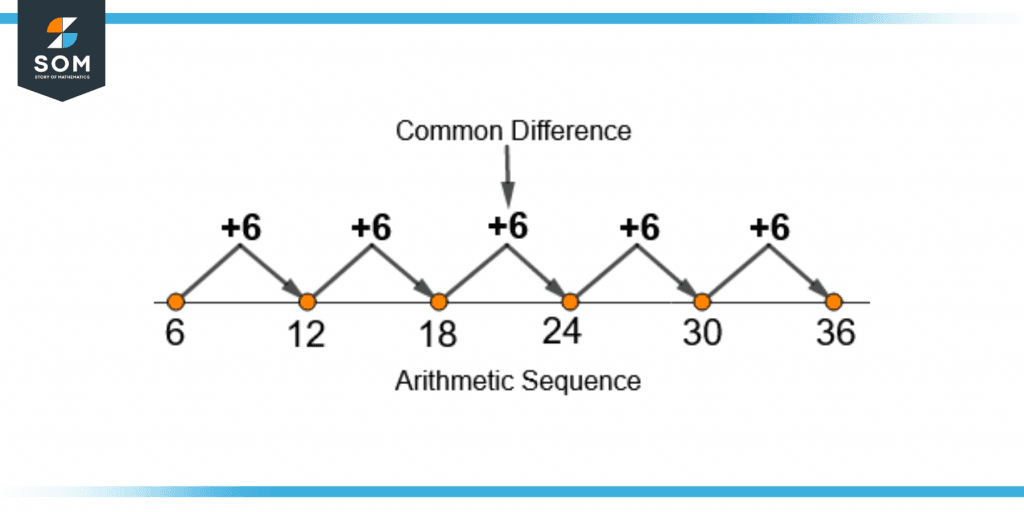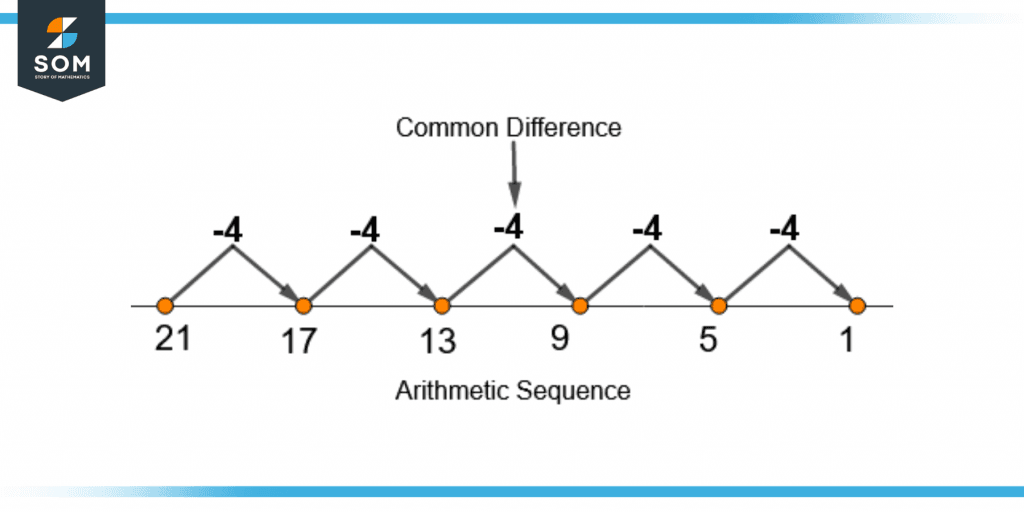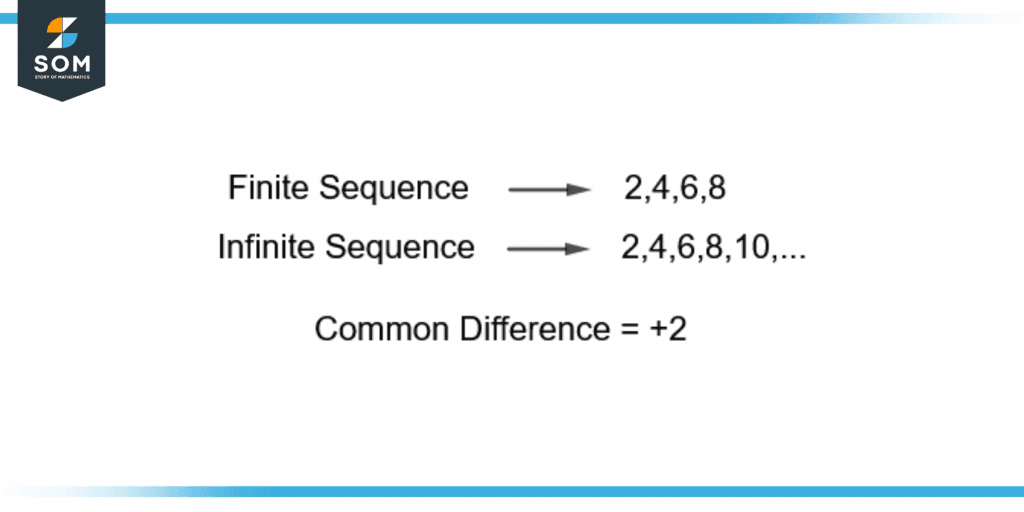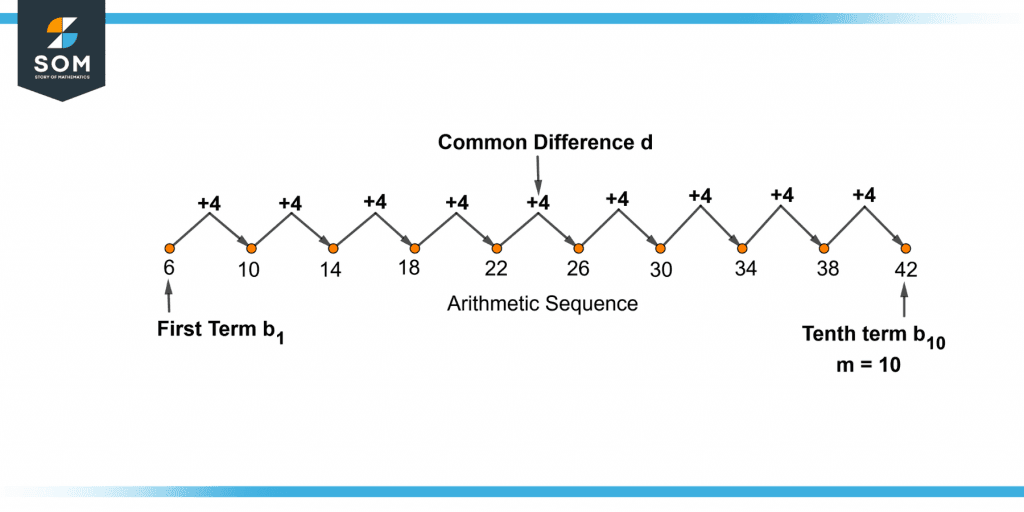JUMP TO TOPIC
- Definition
- Sequences and the Arithmetic Sequence
- Positive Common Difference
- Negative Common Difference
- Common Difference of a Finite and Infinite Arithmetic Sequence
- Importance of Common Differences
- Finding the mth Term of an Arithmetic Sequence
- Example of Finding the Common Difference in an Arithmetic Sequence
Common Difference|Definition & Meaning
Definition
A Common Difference is a number added or subtracted to a arithmetic sequence’s term to obtain the term incoming in the sequence. As this difference is common in all the terms of an arithmetic sequence, it is known as the common difference. It is denoted by d.
Sequences and the Arithmetic Sequence
A set of numerals placed in a definite order is known as a sequence. For example, 1,3,6,10,15 is a sequence.
There are many types of sequences but the arithmetic sequence deals with the concept of common difference. To understand the common difference, one must know about the arithmetic sequence.
An Arithmetic Sequence or progression is an ordered sequence arranged with a common difference between its two consecutive terms.
Positive Common Difference

Figure 1 – Arithmetic Sequence With A Positive Common Difference
An arithmetic sequence with a positive common difference is shown in figure 1. It has the first term as 6, the second as 12, and so on. The common difference d for this sequence is +6.
Negative Common Difference
The arithmetic sequence shown in figure 2 has a negative common difference of -4. Note that the terms of the arithmetic sequence are in descending order.

Figure 2 – Arithmetic Sequence With A Negative Common Difference
Common Difference of a Finite and Infinite Arithmetic Sequence
The arithmetic sequence can be finite or infinite. For example, the arithmetic sequence 3, 7, 11, 15, 19 is finite as it has an ending term of 19. It has a finite number of terms.
On the other hand, the arithmetic sequence 3,6,9,12,… is an infinite sequence as the dots indicate that the terms will go to infinity.
Figure 3 shows a finite and an infinite arithmetic sequence. Both have a common difference of +2.

Figure 3 – Finite And Infinite Arithmetic Sequences
Importance of Common Differences
Common difference plays an essential role in an arithmetic sequence. Without a common difference, the sequence won’t even be arithmetic!
Also, it plays a crucial role in finding the next term or any term of the arithmetic sequence.
Finding the mth Term of an Arithmetic Sequence
An arithmetic sequence consists of many terms. The following steps are required to find the mth term of an arithmetic sequence.
Knowing the First Term
Knowing the first term is essential for computing any arithmetic term. For example, the first term in the arithmetic sequence 6, 10, 14, 18 is 6. It is denoted by $b_{1}$.
Knowing the Common Difference
The common difference d can be calculated by subtracting the second term from the first term. The value of d would be the same by subtracting the third term from the second term.
The mathematical formula for common difference can be generalized as follows:
d = $b_{m+1}$ – $b_{m}$
Where $b_{m+1}$ is the term next to $b_{m}$.
Without knowing the common difference, the mth term cannot be found.
Similarly, the next term $b_{m+1}$ can be calculated if the previous term b_{m} and the common difference d are known. The formula becomes:
$b_{m+1}$ = $b_{m}$ + d
Calculating the mth Term
The following mathematical formula is used to find the mth term of the arithmetic sequence.
$b_{m}$ = $b_{1}$ + ( m – 1 ).d
Here, $b_{m}$ represents the mth term. The m indicates the position of the term in the sequence.
For example, the tenth term is required in the sequence 6, 10, 14, 18 so the value of m will be 10. The first term $b_{1}$ of the sequence is 6.
The common difference can be calculated as follows:
d = $b_{m+1}$ – $b_{m}$
d = $b_{2}$ – $b_{1}$
d = 10 – 6
d = 4
By putting the values of $b_{1}$, m, and d, the tenth term of the sequence is calculated as follows:
$b_{10}$ = 6 + ( 10 – 1 )4
$b_{10}$ = 6 + ( 9 )4
$b_{10}$ = 6 + 36
$b_{10}$ = 42
The mth term can also be calculated by only knowing the common difference.
In the above sequence, 6, 10, 14, 18 the common difference 4 is added till the tenth position of the sequence to find the tenth term. It is shown in figure 4.

Figure 4 – Finding the mth Term Using the Common Difference
Example of Finding the Common Difference in an Arithmetic Sequence
Which of the following sequences is arithmetic? If arithmetic, which has a positive or a negative common difference?
a) 22, 19, 16, 13, 10, 7
b) 30, 34, 38, 42, 46, 50
c) 2, 4, 7, 9, 12
d) 4, 8, 16, 32, 64
Solution
(a) 22, 19, 16, 13, 10, 7
First, the difference between the first term and the second term needs to be calculated. It is
$d_{1}$ = $b_{2}$ – $b_{1}$ = 19 – 22 = -3
Next, the difference between the second and the third term is calculated.
$d_{2}$ = $b_{3}$ – $b_{2}$ = 16 – 19 = -3
As $d_{1}$ is equal to $d_{2}$, the sequence is arithmetic with a negative common difference of d = -3.
(b) 30, 34, 38, 42, 46, 50
The first term is subtracted from the second term to find the difference $d_{1}$ as follows:
$d_{1}$ = $b_{2}$ – $b_{1}$ = 34 – 30 = +4
To check whether this difference is common, the second term is subtracted from the third term as follows:
$d_{2}$ = $b_{3}$ – $b_{2}$ = 38 – 34 = 4
As $d_{1}$ and $d_{2}$ are the same, the sequence has a positive common difference of +4. Hence, the sequence is arithmetic.
(c) 2, 4, 7, 9, 12
Calculating $d_{1}$ and $d_{2}$ to as follows:
$d_{1}$ = $b_{2}$ – $b_{1}$ = 4 – 2 = +2
$d_{2}$ = $b_{3}$ – $b_{2}$ = 7 – 4 = +3
As $d_{1}$ is not equal to $d_{2}$, there is no common difference in the sequence. The sequence is not arithmetic.
(d) 4, 8, 16, 32, 64
Subtracting the first from the second term gives 8 – 4 = 4. Also, the subtracting the second from the third term gives 16 – 8 = 8.
Both the differences are not equal, hence the sequence is not arithmetic.
The given sequence does have a common ratio r which is 2. It means that the first term 4 is multiplied by 2 to get the second term 8.
Similarly, the third term is obtained by multiplying the second term by 2. So, the sequence is geometric.
All the images are created using GeoGebra.
